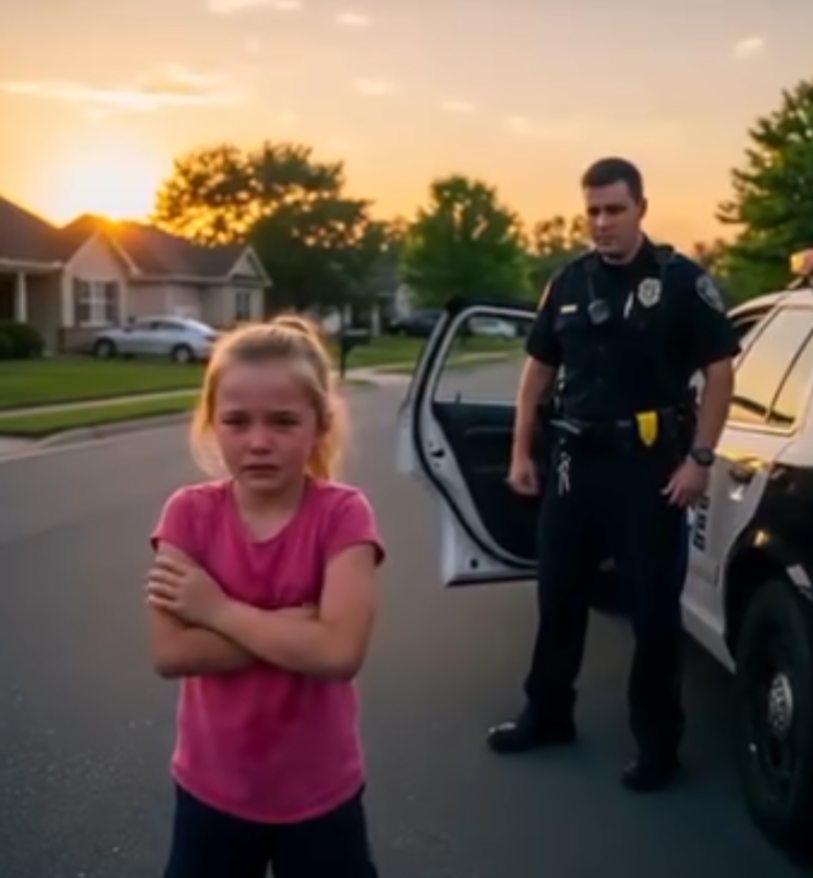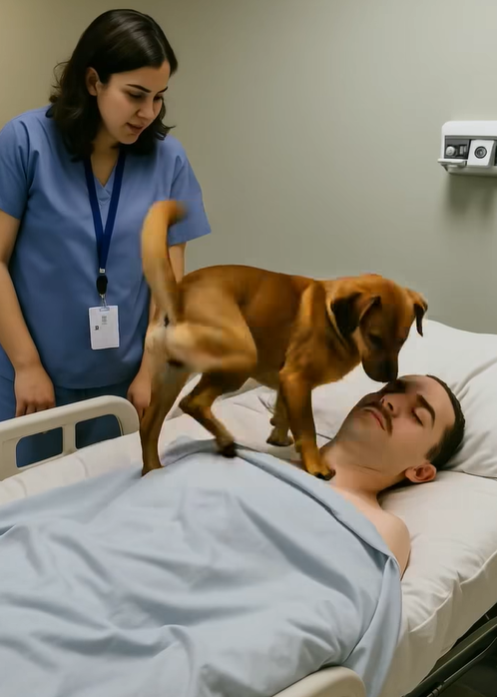A late summer evening in downtown Cleveland was winding down like any other. Officer Daniel Harris was wrapping up his paperwork, eager to head home after another long day serving and protecting the neighborhood he had come to cherish during his twelve years on the police force. The precinct was quiet, with only the occasional crackle from the radio breaking the calm. Outside, the sun was setting, casting soft hues of orange and amber that streamed through the station’s windows. At precisely 7:47 p.m., according to the report later filed, Daniel’s ordinary evening took an unforeseen twist.
As he packed up to leave, a small figure outside the station windows caught his eye. Initially dismissing it as just another kid playing nearby, the urgency in the child’s movements soon became clear. A young girl, barely visible against the backdrop of the bustling street, was sprinting toward the police station. Her pace was frantic—almost desperate—and as she neared, Daniel could hear the unmistakable sound of distressed sobbing piercing the quiet night. This was no ordinary child’s cry over a minor mishap; this was something far more serious.
The girl, who Daniel didn’t yet know was named Emily Carter, burst through the station’s front doors with a sense of urgency that immediately drew his full attention. At just eight years old, she instinctively understood that when trouble arises, you seek help—not run away from it. Her faded pink backpack, showing signs of wear and likely passed down, bounced against her small frame as she hurried up the front steps. Her appearance told a story before she even spoke: her hair, probably neatly brushed that morning, was now tangled and messy; tears had left clear trails on her dust-covered cheeks; and her chest rose and fell rapidly from the exertion of running while crying.
But it was her eyes—wide, frightened, and filled with a depth of desperation beyond her years—that captured Daniel’s full attention.
“Please,” she pleaded, her voice trembling with fear and exhaustion. “Please come with me. You have to come right now!”
Daniel Harris had encountered many situations during his time on the force—domestic disputes, traffic incidents, minor crimes, and countless moments where comfort was needed more than enforcement. His experience had taught him to quickly evaluate situations, judge danger, and respond appropriately. But something about Emily’s plea felt different. Her fear was genuine, raw, and unmistakable.
Without hesitation, Daniel knelt down to meet Emily’s gaze, employing the calming techniques he had learned in training. Getting down to a child’s eye level is one of the most effective ways to build trust and communication—and at that moment, it was crucial.
“Slow down, sweetie. Take a deep breath. What’s your name?” he asked softly but firmly.
“Emily,” she managed between sobs, her small body trembling as she fought to control her emotions. “Emily Carter. Please, you need to hurry. My mom—she needs help!”
The mention of her mother in need immediately raised Daniel’s alertness. Calls involving child welfare were among the most difficult but important calls an officer could face. When a child seeks help for a parent, it often means the situation is urgent.
Daniel caught the eye of his partner, Officer Linda Perez, who was just stepping out of the station with a hot coffee, probably expecting a quiet end to her shift. Linda, with eight years on the force, had the same instincts Daniel did—it was an emergency.
A quick glance at Emily’s tear-streaked face and Daniel’s expression told her everything.
“We need to move. Now,” Daniel said, and Linda promptly set her coffee aside, grabbing her radio and keys.
Emily’s small hand gripped Daniel’s with surprising strength—her hold was both a plea for help and a sign of trust.
“This way, please! Hurry!” she urged, already pulling him toward the exit.
The urgency in her voice left no room for protocol. Sometimes police work demands split-second decisions guided by instinct and experience, and both officers recognized this as one of those times.
After alerting dispatch, they followed Emily out into the cool Cleveland evening.
Emily’s legs carried her swiftly and purposefully. Despite her emotional turmoil, she navigated the neighborhood confidently, as if these streets were well-known. Her crying persisted, but she kept pace, occasionally glancing back to make sure the officers were still behind her.
The path led them away from the busier downtown area to a residential neighborhood that told its own story of economic hardship in urban America. The houses grew smaller and more worn, with peeling paint, sagging fences, and yards that bore the marks of neglect—signs of families working hard but struggling to keep up.
This part of Cleveland was rarely seen by visitors but well-known to Daniel and Linda from their patrols. It was home to hardworking families, single parents juggling multiple jobs, seniors on fixed incomes, and kids who learned resilience out of necessity. It was also a place where neighbors looked out for each other, and where people like Emily learned early on that police officers were helpers, not threats.
Emily’s repeated cries of “Please hurry, please hurry” echoed like a heartbeat throughout their journey. Each repetition carried the weight of a child’s love for her mother and a desperate hope that help would arrive.
Daniel thought about his own children, imagining how he’d want others to act if one of them were in Emily’s shoes.
Though the walk felt endless, it was likely only ten minutes. Time stretches during emergencies—especially when a child’s safety hangs in the balance. Both officers prepared mentally for what they might find: domestic violence, medical emergencies, mental health crises, substance abuse—the possibilities were many.
When they reached Birchwood Street, the sun had nearly set, casting long shadows over the narrow street. The neighborhood reflected its struggles: some homes showed care with small flower gardens and tidy porches, others revealed the strain of limited resources with broken steps and overgrown yards.
Emily’s home was a narrow, single-story house at the end of the block, probably built in the 1950s for working families. The front yard was overgrown, the window cracked but patched with clear tape—a makeshift repair that spoke of resilience amid hardship.
Despite the worn exterior, Daniel noticed small signs of care—a pair of tiny rain boots neatly by the door, a wind chime hanging from the porch, its gentle tinkling adding a touch of warmth.
Emily didn’t hesitate. She climbed the steps, avoiding a loose board with practiced ease, and turned the handle without hesitation—the door was unlocked, a detail that would later matter.
“Mom?” Emily called, her voice a mix of hope and worry. “Mom, I brought help!”
Daniel and Linda followed, alert and observant as they entered the home. Officers are trained to notice exits, potential weapons, signs of struggle, and the condition of the environment.
What they found inside was unlike anything they expected.
The house was small but clean and orderly. Though the furniture was clearly secondhand, it was arranged thoughtfully to create a warm atmosphere. Children’s artwork decorated the refrigerator, and books were neatly stacked on a shelf.
It was clearly a home filled with love, even if money was tight.
But it was the living room scene that stopped them—Emily’s mother, Sarah Carter, lay on the old couch covered with a worn quilt, not injured or unconscious, but surrounded by neighborhood kids of all ages, from toddlers to teens.
Some sat on the floor, others perched on chairs or squeezed onto the couch, all captivated by Sarah reading aloud from a well-worn paperback. Her animated voice brought the story to life.
The officers stood quietly, taking in the unexpected and beautiful sight.
“…and then the brave little mouse said to the enormous cat…” Sarah’s voice carried the magic of storytime. She looked up as they entered, confusion flickering across her face before understanding dawned as she saw Emily’s tear-streaked face.
“Emily, honey, what’s wrong? Why did you bring the police?” Sarah asked, concern clear in her voice.
Emily rushed to her mother, throwing herself into Sarah’s arms.
“I thought—you were sick again, Mom. I thought something bad happened!”
As the story unfolded, Daniel and Linda learned that Sarah was a single mother working two part-time jobs to support Emily. She cleaned offices early mornings and worked at a local diner during lunch, juggling everything to provide for her daughter.
Recently, she’d been battling a lingering flu, hiding the worst of it from Emily. That afternoon, feeling especially weak, she had invited neighborhood kids over for storytime—a small tradition that had grown as word spread that Mrs. Carter was happy to read to any child who wanted to listen.
Emily, coming home from a friend’s house, had seen her mother lying on the couch surrounded by kids and feared the worst. Her eight-year-old mind recalled the time when Sarah had been seriously ill weeks before.
Emily’s fear came from love and the trauma of seeing her mother sick. Not wanting to disrupt the storytime or scare the other children, she slipped out quietly and ran straight to the police for help—logical and touching reasoning for a child: when someone you love needs help, you find those whose job it is to help.
What began as a potential emergency turned into a scene of community and care.
Sarah, despite her challenges, was offering a safe, nurturing space for neighborhood children—helping with homework, bandaging scrapes, mediating disputes, and providing encouragement and warmth.
Children shared stories of how Sarah had become part of their lives, reading to them, making sandwiches, and lending a helping hand.
Linda, a mother herself, was moved. “What you’re doing is amazing. You’re making a real difference.”
Daniel thought about the broader role of policing—beyond emergencies, officers can support community resilience through relationships like these.
As the immediate worry faded and Emily’s tears dried, the officers hesitated to leave. The scene was a powerful reminder of why they served.
The children gradually dispersed, promising to return for the next storytime, some shyly asking officers about their work.
Before leaving, Daniel and Linda discussed with Sarah some resources that might help her support the neighborhood kids more formally—after-school programs, literacy grants, community groups—but Sarah was overwhelmed and preferred to keep things informal, doing what felt right.
Emily tugged at Daniel’s sleeve before they left.
“Officer Daniel, will you come back and visit us?”
The question caught him off guard. Invitations like this were rare in his career, born of genuine trust and affection—a testament to the community bonds officers strive to build.
“I’d like that very much, Emily,” he replied sincerely.
On the walk back, they reflected on the experience. What had begun as a potential crisis revealed a story of hope, kindness, and the strength of community.
Linda broke the silence. “That was beautiful. She’s doing more for those kids than many city programs.”
Daniel nodded. “And Emily’s quick thinking shows remarkable maturity.”
Their conversation turned to the power of everyday heroism, often overlooked amid stories of conflict.
Back at the station, while completing reports, they found it hard to classify the incident. No crime, no emergency—but far from a false alarm.
They wrote detailed notes recommending community outreach follow-up for Sarah, recognizing her positive impact.
Emily’s story spread through the precinct and neighborhood, inspiring others to help and support Sarah’s efforts.
She remained humble, focused on what felt right rather than formal programs.
Emily became a local hero, admired for her courage and quick thinking.
The incident deeply influenced both officers: Daniel began visiting the Carter home informally, strengthening community ties; Linda volunteered with literacy programs and advocated for proactive community engagement.
This story reminds us that heroism and community-building often happen quietly, without fanfare.
Sarah wasn’t saving the world—just responding to the needs around her.
Emily wasn’t trying to be brave—just seeking help for someone she loved.
Together, they sparked positive change, proving that simple kindness can ripple through a community.
For Daniel and Linda, the call was a career-defining moment, showing why they chose to serve.
In a world often dominated by negative news, Emily Carter’s story stands as a beautiful example of love, community, and the power of ordinary people doing extraordinary things.



